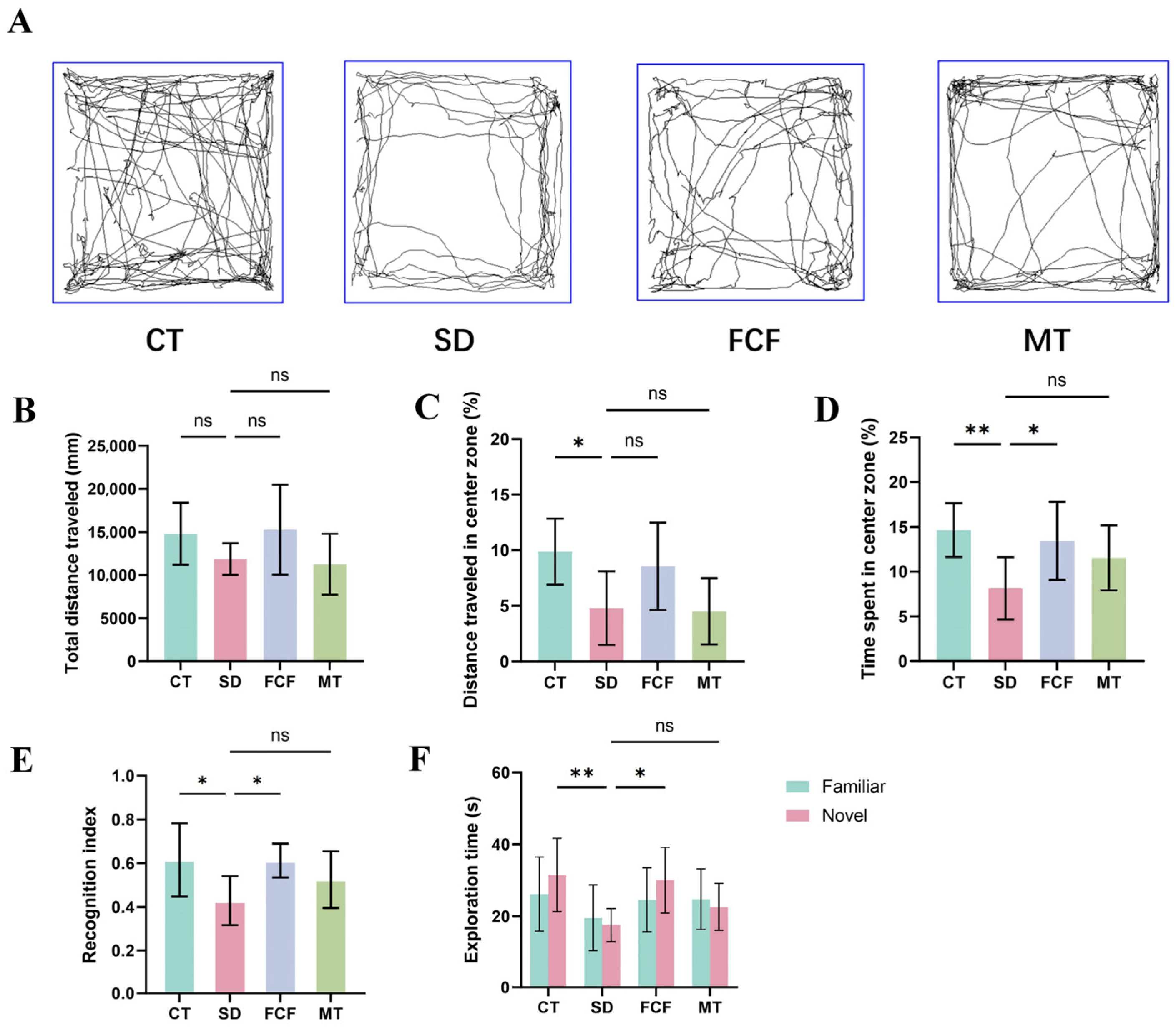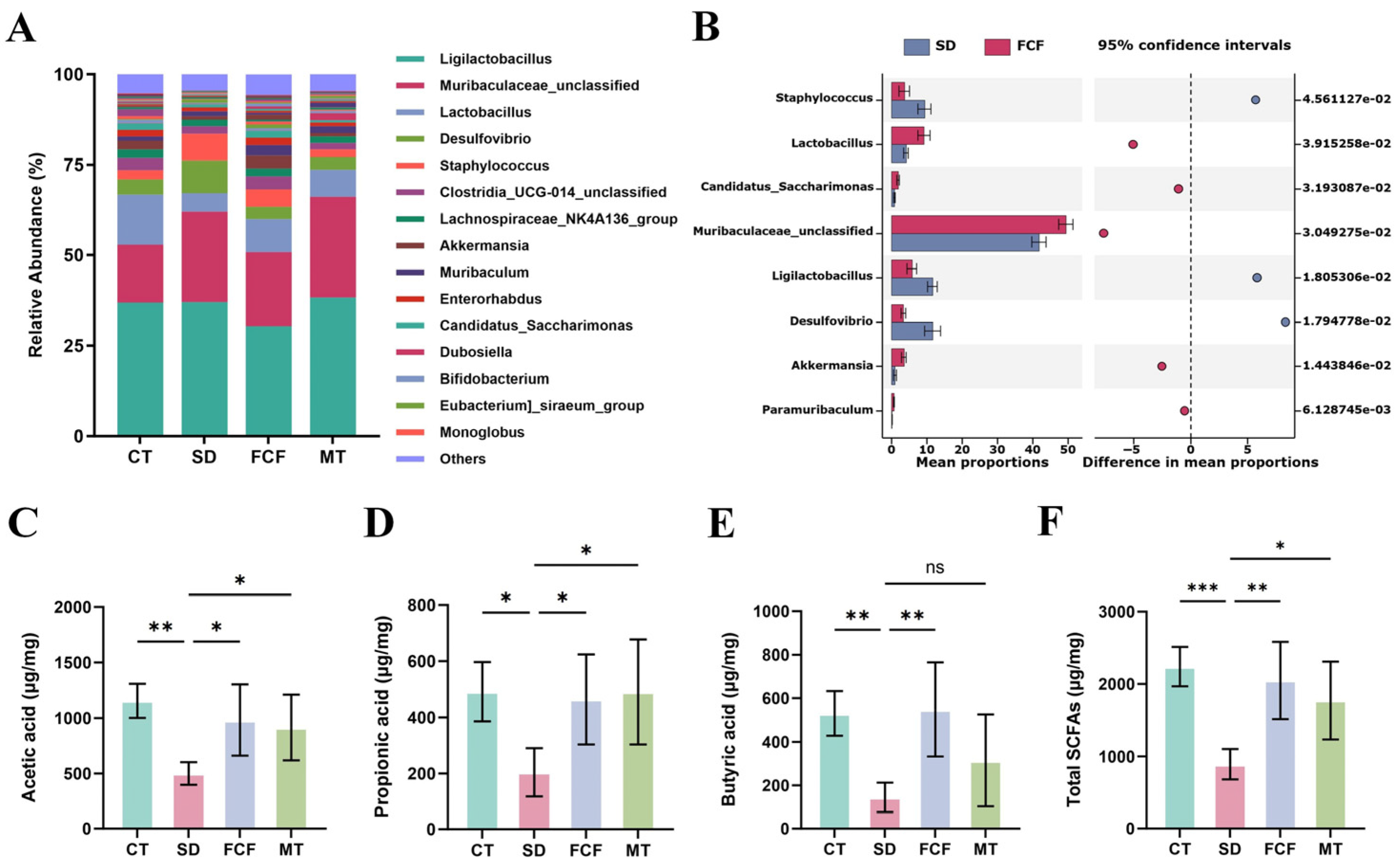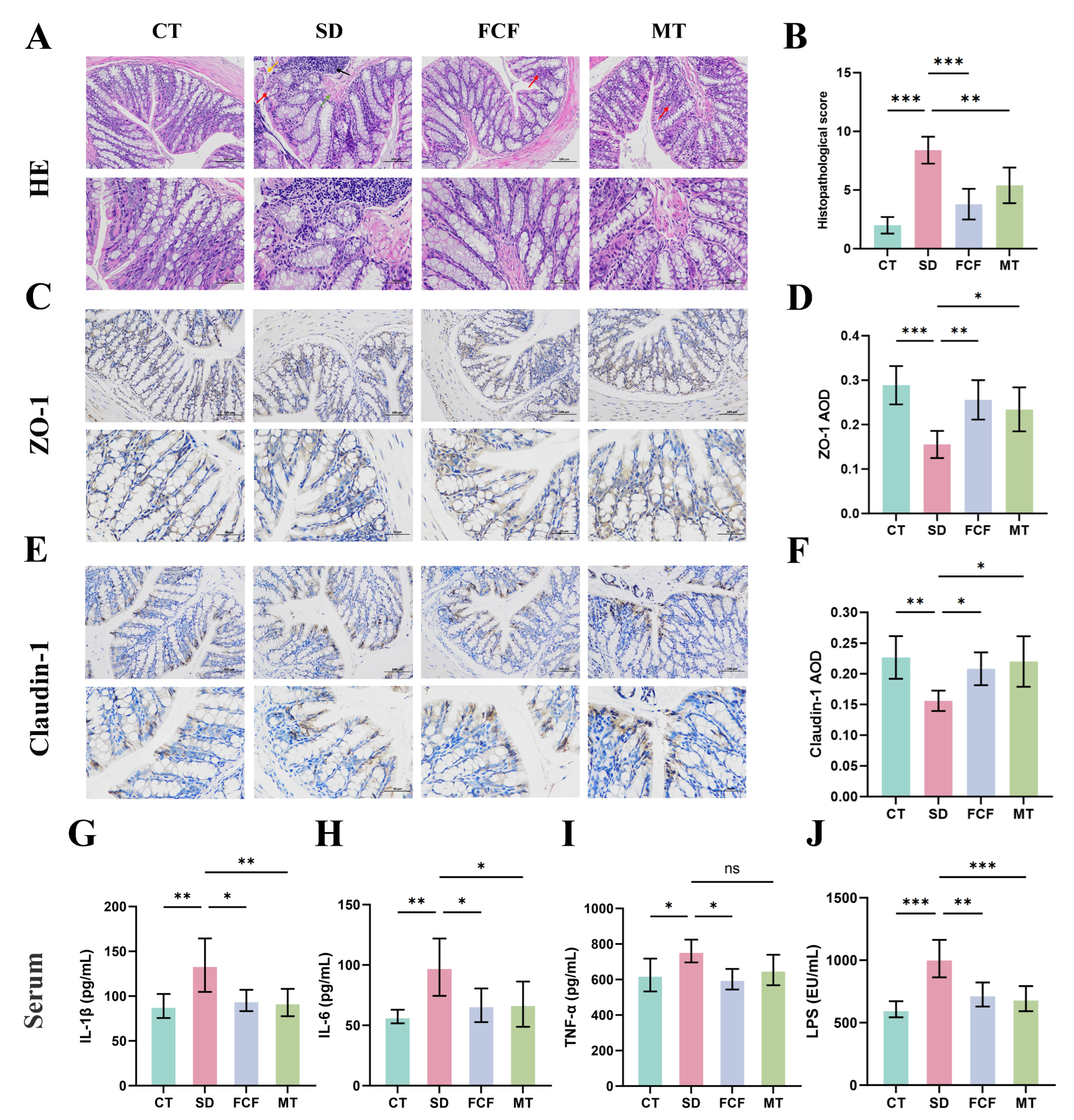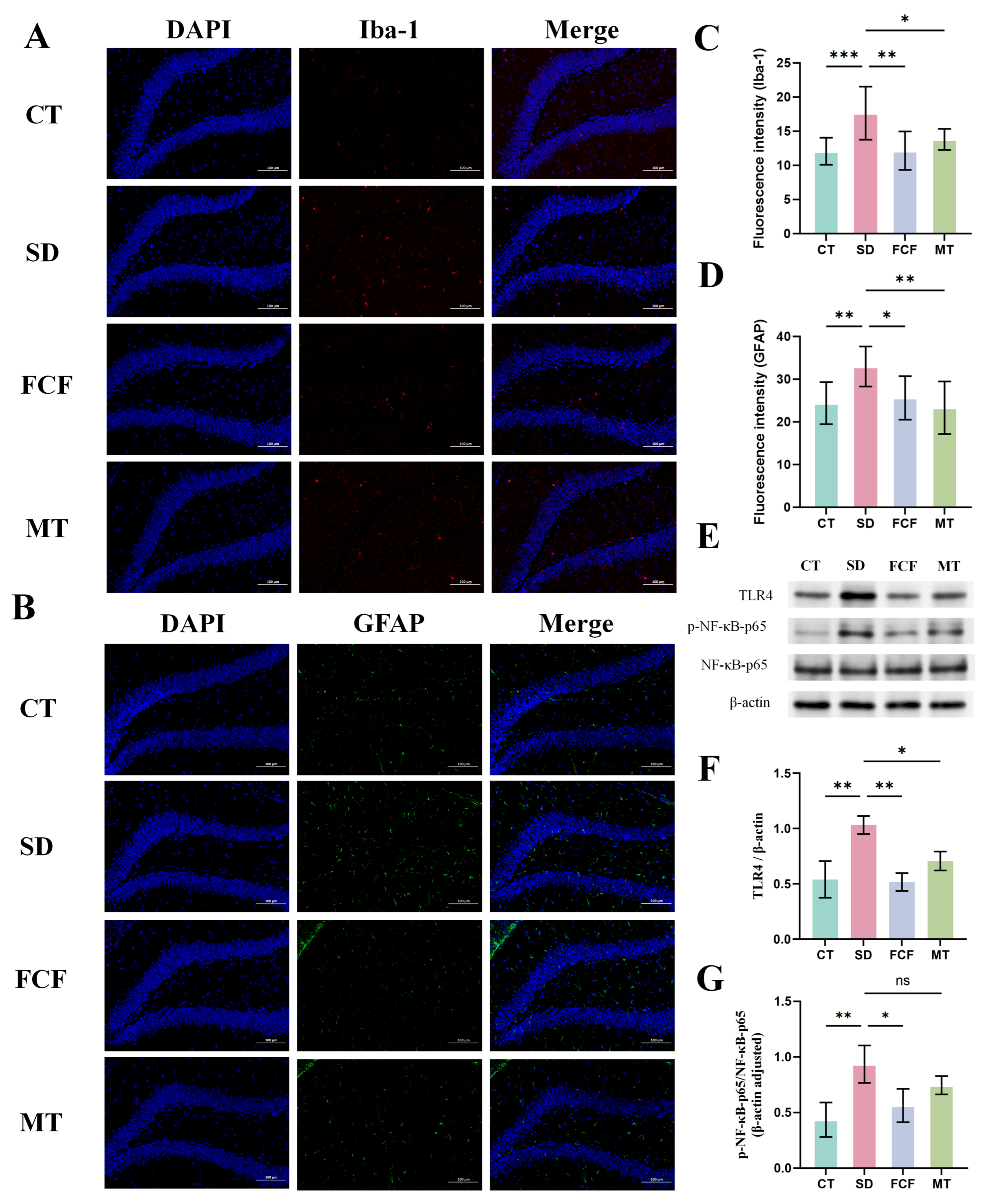Flavonoids from Ficus pandurate var. angustifolia W.C. Cheng Restore Cognitive Impairment and Regulate the Gut Microbiota in Sleep-Deprived Mice
Abstract
1. Introduction
2. Materials and Methods
2.1. Materials and Reagents
2.2. Preparation of FCF
2.3. Analysis of the Components of FCF
2.4. Animal Experiment Design
2.5. Experimental Sample Preparation
2.6. Behavioral Assessment
2.7. Gut Microbiota Analysis
2.8. SCFA Extraction and Analysis
2.9. Histological Examination
2.10. Biochemical Measurement
2.11. Western Blot
2.12. Immunofluorescence Analysis
2.13. Immunohistochemistry Analysis
2.14. Statistical Analysis
3. Results
3.1. Analysis of FCF Components
3.2. Effect of FCF on Body Weight and Spatial Memory in SD Mice
3.3. Effect of FCF on Anxiety-like Behavior and Recognition Memory in SD Mice
3.4. Effect of FCF on the Gut Microbiota and SCFAs of SD Mice
3.5. FCF Alleviates SD-Induced Colon Tissue Damage and Intestinal Inflammation
3.6. Effects of FCF on Activation of Hippocampal Glial Cells and TLR4/NF-κB Signaling Pathway
3.7. FCF Protects Hippocampal Neuronal Cells and Regulates Neurotransmitter Metabolism
4. Discussion
5. Conclusions
Supplementary Materials
Author Contributions
Funding
Institutional Review Board Statement
Informed Consent Statement
Data Availability Statement
Conflicts of Interest
Abbreviations
| FCF | Ficus pandurate var. angustifolia W.C. Cheng flavonoids |
| SD | sleep deprivation |
| SCFAs | short-chain fatty acids |
| LPS | lipopolysaccharide |
| CNS | central nervous system |
| BBB | blood–brain barrier |
| TLR4 | toll-like receptor 4 |
| IL-1β | interleukin-1β |
| TNF-α | tumor necrosis factor-α |
| IL-6 | interleukin-6 |
| 5-HT | 5-hydroxytryptamine |
| GABA | γ-aminobutyric acid |
| GLU | glutamate |
| Iba-1 | ionized calcium-binding adapter molecule 1 |
| GFAP | glial fibrillary acidic protein |
| AOD | average optical density |
| ZO-1 | zonula occludens-1 |
| NF-κB | nuclear factor-kappa B |
References
- Zhang, X.; Xu, F.; Guo, L. The Complete Chloroplast Genome Sequence of Ficus pandurata Hance Var. angustifolia W.C. Cheng (Moraceae). Mitochondrial DNA B Resour. 2022, 7, 1522–1524. [Google Scholar] [CrossRef]
- Dai, W.; Chen, C.; Feng, H.; Li, G.; Peng, W.; Liu, X.; Yang, J.; Hu, X. Protection of Ficus pandurata Hance against Acute Alcohol-Induced Liver Damage in Mice via Suppressing Oxidative Stress, Inflammation, and Apoptosis. J. Ethnopharmacol. 2021, 275, 114140. [Google Scholar] [CrossRef]
- Dai, W.; Pang, X.; Peng, W.; Zhan, X.; Chen, C.; Zhao, W.; Zeng, C.; Mei, Q.; Chen, Q.; Kuang, W.; et al. Liver Protection of a Low-Polarity Fraction from Ficus pandurata Hance, Prepared by Supercritical CO2 Fluid Extraction, on CCl4-Induced Acute Liver Injury in Mice via Inhibiting Apoptosis and Ferroptosis Mediated by Strengthened Antioxidation. Molecules 2023, 28, 2078. [Google Scholar] [CrossRef]
- Shi, Y.; Mon, A.M.; Fu, Y.; Zhang, Y.; Wang, C.; Yang, X.; Wang, Y. The Genus Ficus (Moraceae) Used in Diet: Its Plant Diversity, Distribution, Traditional Uses and Ethnopharmacological Importance. J. Ethnopharmacol. 2018, 226, 185–196. [Google Scholar] [CrossRef]
- Rakha, A.; Umar, N.; Rabail, R.; Butt, M.S.; Kieliszek, M.; Hassoun, A.; Aadil, R.M. Anti-Inflammatory and Anti-Allergic Potential of Dietary Flavonoids: A Review. Biomed. Pharmacother. 2022, 156, 113945. [Google Scholar] [CrossRef] [PubMed]
- Bellavite, P. Neuroprotective Potentials of Flavonoids: Experimental Studies and Mechanisms of Action. Antioxidants 2023, 12, 280. [Google Scholar] [CrossRef] [PubMed]
- Zhang, Y.; Pan, J.; Liu, Y.; Zhang, X.; Cheng, K. Effects of Ficus pandurata Hance Var. angustifolia Cheng Flavonoids on Intestinal Barrier and Cognitive Function by Regulating Intestinal Microbiota. Foods 2023, 12, 1682. [Google Scholar] [CrossRef]
- Von Gall, C.; Holub, L.; Ali, A.A.H.; Eickhoff, S. Timing of Deep and REM Sleep Based on Fitbit Sleep Staging in Young Healthy Adults under Real-Life Conditions. Brain Sci. 2024, 14, 260. [Google Scholar] [CrossRef]
- Wang, W.; Zhao, L.; He, Z.; Zhao, Y.; Jiang, G.; Gong, C.; Zhang, Y.; Yu, J.; Liang, T.; Guo, L. Decoding Multifaceted Roles of Sleep-Related Genes as Molecular Bridges in Chronic Disease Pathogenesis. Int. J. Mol. Sci. 2025, 26, 2872. [Google Scholar] [CrossRef]
- Panagiotou, M.; Meijer, J.H.; Deboer, T. The Effects of Diazepam on Sleep Depend on the Photoperiod. Acta Pharmacol. Sin. 2025, 46, 892–903. [Google Scholar] [CrossRef]
- Richardson, K.; Savva, G.M.; Boyd, P.J.; Aldus, C.; Maidment, I.; Pakpahan, E.; Loke, Y.K.; Arthur, A.; Steel, N.; Ballard, C.; et al. Non-Benzodiazepine Hypnotic Use for Sleep Disturbance in People Aged over 55 Years Living with Dementia: A Series of Cohort Studies. Health Technol. Assess. 2021, 25, 1–202. [Google Scholar] [CrossRef] [PubMed]
- DeKosky, S.T.; Williamson, J.B. The Long and the Short of Benzodiazepines and Sleep Medications: Short-Term Benefits, Long-Term Harms? Neurotherapeutics 2020, 17, 153–155. [Google Scholar] [CrossRef] [PubMed]
- Ramos, A.R.; Wheaton, A.G.; Johnson, D.A. Sleep Deprivation, Sleep Disorders, and Chronic Disease. Prev. Chronic. Dis. 2023, 20, E77. [Google Scholar] [CrossRef] [PubMed]
- Socała, K.; Doboszewska, U.; Szopa, A.; Serefko, A.; Włodarczyk, M.; Zielińska, A.; Poleszak, E.; Fichna, J.; Wlaź, P. The Role of Microbiota-Gut-Brain Axis in Neuropsychiatric and Neurological Disorders. Pharmacol. Res. 2021, 172, 105840. [Google Scholar] [CrossRef]
- Wang, Q.; Yang, Q.; Liu, X. The Microbiota-Gut-Brain Axis and Neurodevelopmental Disorders. Protein Cell 2023, 14, 762–775. [Google Scholar] [CrossRef]
- Cai, J.; Sun, L.; Gonzalez, F.J. Gut Microbiota-Derived Bile Acids in Intestinal Immunity, Inflammation, and Tumorigenesis. Cell Host Microbe 2022, 30, 289–300. [Google Scholar] [CrossRef]
- Magni, G.; Riboldi, B.; Ceruti, S. Modulation of Glial Cell Functions by the Gut-Brain Axis: A Role in Neurodegenerative Disorders and Pain Transmission. Cells 2023, 12, 1612. [Google Scholar] [CrossRef]
- Zhao, N.; Chen, Q.G.; Chen, X.; Liu, X.; Geng, F.; Zhu, M.; Yan, F.; Zhang, Z.; Ren, Q. Intestinal Dysbiosis Mediates Cognitive Impairment via the Intestine and Brain NLRP3 Inflammasome Activation in Chronic Sleep Deprivation. Brain Behav. Immun. 2023, 108, 98–117. [Google Scholar] [CrossRef]
- Wang, Z.; Wang, Z.; Lu, T.; Chen, W.; Yan, W.; Yuan, K.; Shi, L.; Liu, X.; Zhou, X.; Shi, J.; et al. The Microbiota-Gut-Brain Axis in Sleep Disorders. Sleep Med. Rev. 2022, 65, 101691. [Google Scholar] [CrossRef]
- Wang, Z.; Chen, W.; Li, S.; He, Z.; Zhu, W.; Ji, Y.; Wang, Z.; Zhu, X.; Yuan, K.; Bao, Y.; et al. Gut Microbiota Modulates the Inflammatory Response and Cognitive Impairment Induced by Sleep Deprivation. Mol. Psychiatry 2021, 26, 6277–6292. [Google Scholar] [CrossRef]
- Di Vincenzo, F.; Del Gaudio, A.; Petito, V.; Lopetuso, L.R.; Scaldaferri, F. Gut Microbiota, Intestinal Permeability, and Systemic Inflammation: A Narrative Review. Intern. Emerg. Med. 2024, 19, 275–293. [Google Scholar] [CrossRef] [PubMed]
- Vicentini, F.A.; Keenan, C.M.; Wallace, L.E.; Woods, C.; Cavin, J.-B.; Flockton, A.R.; Macklin, W.B.; Belkind-Gerson, J.; Hirota, S.A.; Sharkey, K.A. Intestinal Microbiota Shapes Gut Physiology and Regulates Enteric Neurons and Glia. Microbiome 2021, 9, 210. [Google Scholar] [CrossRef] [PubMed]
- Li, J.; Ma, J.; Li, Q.; He, L.; Zhang, M.; Zheng, L.; Zhang, Y. Rapid Analysis of 18 Flavonoids in Tea by Ultrahigh-Performance Liquid Chromatography Coupled with Quadrupole-Time of Flight Mass Spectrometry. J. Food Qual. 2023, 2023, 3940081. [Google Scholar] [CrossRef]
- Yin, M.; Chen, Y.; Zheng, H.; Pu, T.; Marshall, C.; Wu, T.; Xiao, M. Assessment of Mouse Cognitive and Anxiety-like Behaviors and Hippocampal Inflammation Following a Repeated and Intermittent Paradoxical Sleep Deprivation Procedure. Behav. Brain Res. 2017, 321, 69–78. [Google Scholar] [CrossRef]
- Seo, M.K.; Jeong, S.; Seog, D.-H.; Lee, J.A.; Lee, J.-H.; Lee, Y.; McIntyre, R.S.; Park, S.W.; Lee, J.G. Effects of Liraglutide on Depressive Behavior in a Mouse Depression Model and Cognition in the Probe Trial of Morris Water Maze Test. J. Affect. Disord. 2023, 324, 8–15. [Google Scholar] [CrossRef]
- Zhou, B.; Jin, G.; Pang, X.; Mo, Q.; Bao, J.; Liu, T.; Wu, J.; Xie, R.; Liu, X.; Liu, J.; et al. Lactobacillus Rhamnosus GG Colonization in Early Life Regulates Gut-Brain Axis and Relieves Anxiety-like Behavior in Adulthood. Pharmacol. Res. 2022, 177, 106090. [Google Scholar] [CrossRef]
- Wu, C.; Yang, L.; Li, Y.; Dong, Y.; Yang, B.; Tucker, L.D.; Zong, X.; Zhang, Q. Effects of Exercise Training on Anxious-Depressive-like Behavior in Alzheimer Rat. Med. Sci. Sports Exerc. 2020, 52, 1456–1469. [Google Scholar] [CrossRef]
- Callahan, B.J.; McMurdie, P.J.; Rosen, M.J.; Han, A.W.; Johnson, A.J.A.; Holmes, S.P. DADA2: High-Resolution Sample Inference from Illumina Amplicon Data. Nat. Methods 2016, 13, 581–583. [Google Scholar] [CrossRef]
- Bolyen, E.; Rideout, J.R.; Dillon, M.R.; Bokulich, N.A.; Abnet, C.C.; Al-Ghalith, G.A.; Alexander, H.; Alm, E.J.; Arumugam, M.; Asnicar, F.; et al. Reproducible, Interactive, Scalable and Extensible Microbiome Data Science Using QIIME 2. Nat. Biotechnol. 2019, 37, 852–857. [Google Scholar] [CrossRef]
- Inoue, H.; Takayama, K.; Takahara, C.; Tabuchi, N.; Okamura, N.; Narahara, N.; Kojima, E.; Date, Y.; Tsuruta, Y. Determination of Short-Chain Fatty Acids in Mouse Feces by High-Performance Liquid Chromatography Using 2-Nitrophenylhydrazine as a Labeling Reagent. Biol. Pharm. Bull. 2019, 42, 845–849. [Google Scholar] [CrossRef]
- Chen, Z.; Gao, Z.; Wu, Y.; Shrestha, R.; Imai, H.; Uemura, N.; Hirano, K.-I.; Chiba, H.; Hui, S.-P. Development of a Simultaneous Quantitation for Short-, Medium-, Long-, and Very Long-Chain Fatty Acids in Human Plasma by 2-Nitrophenylhydrazine-Derivatization and Liquid Chromatography-Tandem Mass Spectrometry. J. Chromatogr. B Anal. Technol. Biomed. Life Sci. 2019, 1126–1127, 121771. [Google Scholar] [CrossRef] [PubMed]
- Ren, C.; Tan, P.; Gao, L.; Zeng, Y.; Hu, S.; Chen, C.; Tang, N.; Chen, Y.; Zhang, W.; Qin, Y.; et al. Melatonin Reduces Radiation-Induced Ferroptosis in Hippocampal Neurons by Activating the PKM2/NRF2/GPX4 Signaling Pathway. Prog. Neuropsychopharmacol. Biol. Psychiatry 2023, 126, 110777. [Google Scholar] [CrossRef] [PubMed]
- Wang, F.; Yang, G.; Song, H.; Xiong, L.; Wang, L.; Shen, X. The Guideline for Western Blotting Assay. Food Front. 2022, 3, 347–349. [Google Scholar] [CrossRef]
- Seguella, L.; Pesce, M.; Capuano, R.; Casano, F.; Pesce, M.; Corpetti, C.; Vincenzi, M.; Maftei, D.; Lattanzi, R.; Del Re, A.; et al. High-Fat Diet Impairs Duodenal Barrier Function and Elicits Glia-Dependent Changes along the Gut-Brain Axis That Are Required for Anxiogenic and Depressive-like Behaviors. J. NeuroInflamm. 2021, 18, 115. [Google Scholar] [CrossRef]
- Aktas, B.; Aslim, B.; Ozdemir, D.A. A Neurotherapeutic Approach with Lacticaseibacillus Rhamnosus E9 on Gut Microbiota and Intestinal Barrier in MPTP-Induced Mouse Model of Parkinson’s Disease. Sci. Rep. 2024, 14, 15460. [Google Scholar] [CrossRef]
- Ma, Y.; Liang, L.; Zheng, F.; Shi, L.; Zhong, B.; Xie, W. Association between Sleep Duration and Cognitive Decline. JAMA Netw. Open 2020, 3, e2013573. [Google Scholar] [CrossRef]
- Griffin, S.M.; Lehtinen, M.J.; Meunier, J.; Ceolin, L.; Roman, F.J.; Patterson, E. Restorative Effects of Probiotics on Memory Impairment in Sleep-Deprived Mice. Nutr. Neurosci. 2023, 26, 254–264. [Google Scholar] [CrossRef]
- Lu, C.; Wang, Y.; Lv, J.; Jiang, N.; Fan, B.; Qu, L.; Li, Y.; Chen, S.; Wang, F.; Liu, X. Ginsenoside Rh2 Reverses Sleep Deprivation-Induced Cognitive Deficit in Mice. Behav. Brain Res. 2018, 349, 109–115. [Google Scholar] [CrossRef]
- Amabebe, E.; Robert, F.O.; Agbalalah, T.; Orubu, E.S.F. Microbial Dysbiosis-Induced Obesity: Role of Gut Microbiota in Homoeostasis of Energy Metabolism. Br. J. Nutr. 2020, 123, 1127–1137. [Google Scholar] [CrossRef]
- Smolinska, S.; Popescu, F.-D.; Zemelka-Wiacek, M. A Review of the Influence of Prebiotics, Probiotics, Synbiotics, and Postbiotics on the Human Gut Microbiome and Intestinal Integrity. J. Clin. Med. 2025, 14, 3673. [Google Scholar] [CrossRef]
- Zheng, Y.; Zhang, Z.; Tang, P.; Wu, Y.; Zhang, A.; Li, D.; Wang, C.; Wan, J.; Yao, H.; Yuan, C. Probiotics Fortify Intestinal Barrier Function: A Systematic Review and Meta-Analysis of Randomized Trials. Front. Immunol. 2023, 14, 1143548. [Google Scholar] [CrossRef]
- Wu, Y.; Jha, R.; Li, A.; Liu, H.; Zhang, Z.; Zhang, C.; Zhai, Q.; Zhang, J. Probiotics (Lactobacillus plantarum Hnu082) Supplementation Relieves Ulcerative Colitis by Affecting Intestinal Barrier Functions, Immunity-Related Gene Expression, Gut Microbiota, and Metabolic Pathways in Mice. Microbiol. Spectr. 2022, 10, e0165122. [Google Scholar] [CrossRef]
- Wang, Y.; Li, C.; Li, J.; Zhang, S.; Zhang, Q.; Duan, J.; Guo, J. Abelmoschus manihot Polysaccharide Fortifies Intestinal Mucus Barrier to Alleviate Intestinal Inflammation by Modulating Akkermansia muciniphila Abundance. Acta Pharm. Sin. B 2024, 14, 3901–3915. [Google Scholar] [CrossRef]
- Huang, G.; Zheng, Y.; Zhang, N.; Huang, G.; Zhang, W.; Li, Q.; Ren, X. Desulfovibrio vulgaris Caused Gut Inflammation and Aggravated DSS-Induced Colitis in C57BL/6 Mice Model. Gut Pathog. 2024, 16, 39. [Google Scholar] [CrossRef] [PubMed]
- Ma, X.; Jin, H.; Chu, X.; Dai, W.; Tang, W.; Zhu, J.; Wang, F.; Yang, X.; Li, W.; Liu, G.; et al. The Host CYP1A1-Microbiota Metabolic Axis Promotes Gut Barrier Disruption in Methicillin-Resistant Staphylococcus aureus-Induced Abdominal Sepsis. Front. Microbiol. 2022, 13, 802409. [Google Scholar] [CrossRef] [PubMed]
- Xia, N.; Xu, L.; Huang, M.; Xu, D.; Li, Y.; Wu, H.; Mei, Z.; Yu, Z. Neuroprotection of Macamide in a Mouse Model of Alzheimer’s Disease Involves Nrf2 Signaling Pathway and Gut Microbiota. Eur. J. Pharmacol. 2024, 975, 176638. [Google Scholar] [CrossRef] [PubMed]
- Shabbir, U.; Rubab, M.; Daliri, E.B.-M.; Chelliah, R.; Javed, A.; Oh, D.-H. Curcumin, Quercetin, Catechins and Metabolic Diseases: The Role of Gut Microbiota. Nutrients 2021, 13, 206. [Google Scholar] [CrossRef]
- Liu, D.; Wang, Q.; Li, Y.; Yuan, Z.; Liu, Z.; Guo, J.; Li, X.; Zhang, W.; Tao, Y.; Mei, J. Fructus Gardeniae Ameliorates Anxiety-like Behaviors Induced by Sleep Deprivation via Regulating Hippocampal Metabolomics and Gut Microbiota. Front. Cell. Infect. Microbiol. 2023, 13, 1167312. [Google Scholar] [CrossRef]
- Cryan, J.F.; O’Riordan, K.J.; Cowan, C.S.M.; Sandhu, K.V.; Bastiaanssen, T.F.S.; Boehme, M.; Codagnone, M.G.; Cussotto, S.; Fulling, C.; Golubeva, A.V.; et al. The Microbiota-Gut-Brain Axis. Physiol. Rev. 2019, 99, 1877–2013. [Google Scholar] [CrossRef]
- Ahmed, H.; Leyrolle, Q.; Koistinen, V.; Kärkkäinen, O.; Layé, S.; Delzenne, N.; Hanhineva, K. Microbiota-Derived Metabolites as Drivers of Gut-Brain Communication. Gut Microbes 2022, 14, 2102878. [Google Scholar] [CrossRef]
- Lin, X.; Peng, Y.; Guo, Z.; He, W.; Guo, W.; Feng, J.; Lu, L.; Liu, Q.; Xu, P. Short-Chain Fatty Acids Suppresses Astrocyte Activation by Amplifying Trp-AhR-AQP4 Signaling in Experimental Autoimmune Encephalomyelitis Mice. Cell. Mol. Life Sci. 2024, 81, 293. [Google Scholar] [CrossRef] [PubMed]
- Erny, D.; Dokalis, N.; Mezö, C.; Castoldi, A.; Mossad, O.; Staszewski, O.; Frosch, M.; Villa, M.; Fuchs, V.; Mayer, A.; et al. Microbiota-Derived Acetate Enables the Metabolic Fitness of the Brain Innate Immune System during Health and Disease. Cell Metab. 2021, 33, 2260–2276.e7. [Google Scholar] [CrossRef] [PubMed]
- Mann, E.R.; Lam, Y.K.; Uhlig, H.H. Short-Chain Fatty Acids: Linking Diet, the Microbiome and Immunity. Nat. Rev. Immunol. 2024, 24, 577–595. [Google Scholar] [CrossRef] [PubMed]
- You, X.-Y.; Zhang, H.-Y.; Han, X.; Wang, F.; Zhuang, P.-W.; Zhang, Y.-J. Intestinal Mucosal Barrier Is Regulated by Intestinal Tract Neuro-Immune Interplay. Front. Pharmacol. 2021, 12, 659716. [Google Scholar] [CrossRef]
- Li, G.; Gao, M.; Zhang, S.; Dai, T.; Wang, F.; Geng, J.; Rao, J.; Qin, X.; Qian, J.; Zuo, L.; et al. Sleep Deprivation Impairs Intestinal Mucosal Barrier by Activating Endoplasmic Reticulum Stress in Goblet Cells. Am. J. Pathol. 2024, 194, 85–100. [Google Scholar] [CrossRef]
- Yuan, Y.; Gao, W.; Gao, Y.; Zhang, Q.; Shi, Y.; Zhang, N.; Song, G.; Hu, L.; Jiang, Y.; Liu, J.; et al. Astragali Radix Vesicle-like Nanoparticles Improve Energy Metabolism Disorders by Repairing the Intestinal Mucosal Barrier and Regulating Amino Acid Metabolism in Sleep-Deprived Mice. J. Nanobiotechnol. 2024, 22, 768. [Google Scholar] [CrossRef]
- Gao, T.; Wang, Z.; Cao, J.; Dong, Y.; Chen, Y. Melatonin Alleviates Oxidative Stress in Sleep Deprived Mice: Involvement of Small Intestinal Mucosa Injury. Int. Immunopharmacol. 2020, 78, 106041. [Google Scholar] [CrossRef]
- Wade, H.; Pan, K.; Duan, Q.; Kaluzny, S.; Pandey, E.; Fatumoju, L.; Saraswathi, V.; Wu, R.; Harris, E.N.; Su, Q. Akkermansia Muciniphila and Its Membrane Protein Ameliorates Intestinal Inflammatory Stress and Promotes Epithelial Wound Healing via CREBH and miR-143/145. J. Biomed. Sci. 2023, 30, 38. [Google Scholar] [CrossRef]
- Darwish, S.F.; Elbadry, A.M.M.; Elbokhomy, A.S.; Salama, G.A.; Salama, R.M. The Dual Face of Microglia (M1/M2) as a Potential Target in the Protective Effect of Nutraceuticals against Neurodegenerative Diseases. Front. Aging 2023, 4, 1231706. [Google Scholar] [CrossRef]
- Endo, F.; Kasai, A.; Soto, J.S.; Yu, X.; Qu, Z.; Hashimoto, H.; Gradinaru, V.; Kawaguchi, R.; Khakh, B.S. Molecular Basis of Astrocyte Diversity and Morphology across the CNS in Health and Disease. Science 2022, 378, eadc9020. [Google Scholar] [CrossRef]
- Singh, D. Astrocytic and Microglial Cells as the Modulators of Neuroinflammation in Alzheimer’s Disease. J. Neuroinflamm. 2022, 19, 206. [Google Scholar] [CrossRef]
- Wang, M.; Pan, W.; Xu, Y.; Zhang, J.; Wan, J.; Jiang, H. Microglia-Mediated Neuroinflammation: A Potential Target for the Treatment of Cardiovascular Diseases. J. Inflamm. Res. 2022, 15, 3083–3094. [Google Scholar] [CrossRef]
- Rosa, J.M.; Farré-Alins, V.; Ortega, M.C.; Navarrete, M.; Lopez-Rodriguez, A.B.; Palomino-Antolín, A.; Fernández-López, E.; Vila-Del Sol, V.; Decouty, C.; Narros-Fernández, P.; et al. TLR4 Pathway Impairs Synaptic Number and Cerebrovascular Functions through Astrocyte Activation Following Traumatic Brain Injury. Br. J. Pharmacol. 2021, 178, 3395–3413. [Google Scholar] [CrossRef] [PubMed]
- Wang, H.; Zhang, M.; Li, J.; Liang, J.; Yang, M.; Xia, G.; Ren, Y.; Zhou, H.; Wu, Q.; He, Y.; et al. Gut Microbiota Is Causally Associated with Poststroke Cognitive Impairment through Lipopolysaccharide and Butyrate. J. Neuroinflamm. 2022, 19, 76. [Google Scholar] [CrossRef] [PubMed]
- Zhang, J.; Fan, W.; Neng, L.; Chen, B.; Wang, Y.; Zuo, B.; Lu, W. Adenosine Improves LPS-Induced ROS Expression and Increasing in Monolayer Permeability of Endothelial Cell via Acting on A2AR. Microvasc. Res. 2022, 143, 104403. [Google Scholar] [CrossRef]
- Grylls, A.; Seidler, K.; Neil, J. Link between Microbiota and Hypertension: Focus on LPS/TLR4 Pathway in Endothelial Dysfunction and Vascular Inflammation, and Therapeutic Implication of Probiotics. Biomed. Pharmacother. 2021, 137, 111334. [Google Scholar] [CrossRef] [PubMed]
- Cameron, E.G.; Nahmou, M.; Toth, A.B.; Heo, L.; Tanasa, B.; Dalal, R.; Yan, W.; Nallagatla, P.; Xia, X.; Hay, S.; et al. A Molecular Switch for Neuroprotective Astrocyte Reactivity. Nature 2024, 626, 574–582. [Google Scholar] [CrossRef]
- Zhang, Y.; Xie, Y.; Cheng, Z.; Xi, K.; Huang, X.; Kuang, F.; Wang, W.; Liu, T.; Guo, B.; Wu, S. Quercetin Ameliorates Memory Impairment by Inhibiting Abnormal Microglial Activation in a Mouse Model of Paradoxical Sleep Deprivation. Biochem. Biophys. Res. Commun. 2022, 632, 10–16. [Google Scholar] [CrossRef]
- Fu, X.; Yan, S.; Hu, Z.; Sheng, W.; Li, W.; Kuang, S.; Feng, X.; Liu, L.; Zhang, W.; He, Q. Guhan Yangsheng Jing Mitigates Hippocampal Neuronal Pyroptotic Injury and Manifies Learning and Memory Capabilities in Sleep Deprived Mice via the NLRP3/Caspase1/GSDMD Signaling Pathway. J. Ethnopharmacol. 2024, 326, 117972. [Google Scholar] [CrossRef]
- Dicks, L.M.T. Our Mental Health Is Determined by an Intrinsic Interplay between the Central Nervous System, Enteric Nerves, and Gut Microbiota. Int. J. Mol. Sci. 2023, 25, 38. [Google Scholar] [CrossRef]
- Dicks, L.M.T. Gut Bacteria and Neurotransmitters. Microorganisms 2022, 10, 1838. [Google Scholar] [CrossRef]
- Guan, D.; Hou, Z.; Fan, B.; Bai, Y.; Wu, H.; Yu, J.; Xie, H.; Duan, Z.; Wang, F.; Wang, Q. The Extract of Piper nigrum Improves the Cognitive Impairment and Mood in Sleep-Deprived Mice Through the JAK1/STAT3 Signalling Pathway. Int. J. Mol. Sci. 2025, 26, 1842. [Google Scholar] [CrossRef]
- Jiang, N.; Yao, C.; Zhang, Y.; Sun, X.; Choudhary, M.I.; Liu, X. Ginsenoside Rg1 Attenuates Chronic Sleep Deprivation-Induced Hippocampal Mitochondrial Dysfunction and Improves Memory by the AMPK-SIRT3 Pathway. J. Agric. Food Chem. 2024, 72, 2362–2373. [Google Scholar] [CrossRef]
- Wang, W.; He, M.; Cai, R.; Yu, S.; Long, P.; Zhang, Y.; Wen, X. Triphala Ameliorates Cognitive Deficits and Anxiety via Activation of the Nrf2/HO-1 Axis in Chronic Sleep-Deprived Mice. Int. Immunopharmacol. 2024, 142, 113179. [Google Scholar] [CrossRef]







| Components | Content (mg/g) |
|---|---|
| Genistein and Apigenin | 226.81 ± 12.74 |
| Luteolin | 178.23 ± 10.48 |
| Rutin | 155.62 ± 8.19 |
| Cynaroside | 63.67 ± 4.92 |
| Isoquercitrin and Hyperoside | 18.92 ± 1.81 |
Disclaimer/Publisher’s Note: The statements, opinions and data contained in all publications are solely those of the individual author(s) and contributor(s) and not of MDPI and/or the editor(s). MDPI and/or the editor(s) disclaim responsibility for any injury to people or property resulting from any ideas, methods, instructions or products referred to in the content. |
© 2025 by the authors. Licensee MDPI, Basel, Switzerland. This article is an open access article distributed under the terms and conditions of the Creative Commons Attribution (CC BY) license (https://creativecommons.org/licenses/by/4.0/).
Share and Cite
Dai, H.; Luo, S.; Zhang, X. Flavonoids from Ficus pandurate var. angustifolia W.C. Cheng Restore Cognitive Impairment and Regulate the Gut Microbiota in Sleep-Deprived Mice. Foods 2025, 14, 2888. https://doi.org/10.3390/foods14162888
Dai H, Luo S, Zhang X. Flavonoids from Ficus pandurate var. angustifolia W.C. Cheng Restore Cognitive Impairment and Regulate the Gut Microbiota in Sleep-Deprived Mice. Foods. 2025; 14(16):2888. https://doi.org/10.3390/foods14162888
Chicago/Turabian StyleDai, Haochen, Songmei Luo, and Xin Zhang. 2025. "Flavonoids from Ficus pandurate var. angustifolia W.C. Cheng Restore Cognitive Impairment and Regulate the Gut Microbiota in Sleep-Deprived Mice" Foods 14, no. 16: 2888. https://doi.org/10.3390/foods14162888
APA StyleDai, H., Luo, S., & Zhang, X. (2025). Flavonoids from Ficus pandurate var. angustifolia W.C. Cheng Restore Cognitive Impairment and Regulate the Gut Microbiota in Sleep-Deprived Mice. Foods, 14(16), 2888. https://doi.org/10.3390/foods14162888








